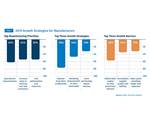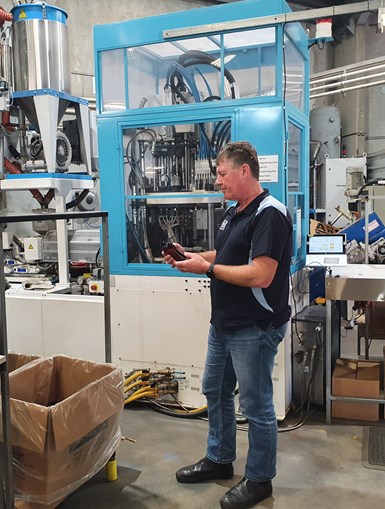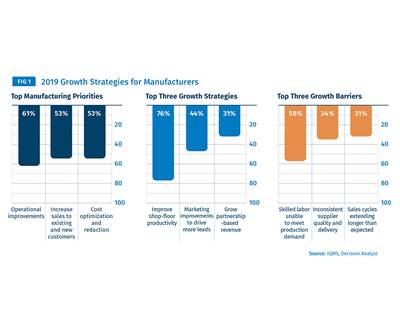Think back to last January. The economy was booming, machines were running day and night, 401k’s were soaring, and our biggest concern was finding additional labor. Fewer than 12 months later there are a whole new set of priorities and concerns. We discovered how vulnerable life and business can be, learned to adapt and improvise, and opportunistically embraced new approaches for getting things done.
At home, the kitchen table was transformed to accommodate distance learning for our children. We gave the Internet a workout with online ordering of everything from household supplies and groceries to pizza. And we gained a whole new appreciation for social gatherings with family and friends over the web.
But changes on the home front could not compare with what was transpiring at the office, on the production floor, and throughout the plant. We learned that such populated environments created health risks, from which no one from the general manager to the machine operator was immune. We learned what it was like to work from home. And companies that weren’t prepared discovered—often the hard way—that collaborating with coworkers, customers and suppliers was challenging, to say the least.
Going Digital
Today, just as before, plastics processors are focusing their attention on new equipment and technologies to boost production speed and capabilities. We look forward to once again attending trade shows to investigate new production equipment and to eagerly to embrace technology advances that could give our business an edge while mingling with our long-time suppliers. But what was that edge in recent months, and what did we discover?
While plastics processors have implemented many improvements in the past year, digital tools have, for the most part, been greatly underutilized or altogether ignored. Offering tremendous benefits and a high return on investment, the digital world leverages the collective and seamless interaction of web-based collaboration, IT-PLC real-time production tracking, integrated business applications, and online B2B customer-portal capabilities.
Digital tools have, for the most part, been greatly underutilized or altogether ignored.
While many industries have readily embraced digital B2B (business-to-business) tools and practices, these past few months have exposed some serious gaps for plastics processors. Despite crippled supply chains, and sometimes being understaffed, plastic processors supplying test kits, mask shields, ventilator parts, and other parts were considered essential service providers and remained operational throughout the pandemic.
During this time many learned that the B2B communication capabilities they had in place (if any) were quickly overwhelmed with the massive volume and rendered largely ineffective. Consequently, many reverted to emails, text messages, phone calls, as well as other manually intensive processes. The result was unreliable connectivity, limited information access, delayed responsiveness, and total frustration.
For plastics processors, weathering the storm was just the beginning, and “business as usual” no longer exists. Agility and responsiveness are the new keywords; and long-term survival will depend on embracing the new tools, ideas, and business practices that support this new paradigm. We’re living in a digital world. The days of spreadsheets, paper-based scheduling, manual inventory, face-to-face meetings, and other inefficient business-to-business practices are on their way out. Plastic processors who make the investment in new IT-Web technologies will emerge from the pandemic with a competitive edge.
For plastics processors, weathering the storm was just the beginning, and “business as usual” no longer exists.
Aside from the internal collaboration and operational benefits to the company, demonstrating digital aptitude and commitment will become a key differentiator in the customer’s eyes. In fact, for many manufacturers evaluating suppliers, this is nothing short of a game changer. Customers recognize the value of seamless communication, reliable connectivity, and online access to realtime information from your shop floor.
And so, if your interest in the digital era has been limited to that cellphone in your pocket, now is the time to get up to speed. Here are some things to consider to help get the ball rolling in your company:
• Working Remotely: The home office has its advantages for the employee and company alike. Contrary to what one might expect, studies show that working from home increases productivity. On average, remote employees work 1½ more days each month than their office-based counterparts. That comes to more than three additional weeks a year. From the company’s perspective, this agile work strategy is shown to increase employee satisfaction, reduce attrition and unscheduled absences, and cut down on wasted meetings, time lost in traffic, and expenses tied to unneeded office space.
Creating a remote work environment doesn’t have to be complex or costly. It does, however, require the appropriate IT infrastructure. A reliable web-based, integrated business-system architecture will provide realtime information access across the board.
While every job isn’t suited for the home, it can be ideal for a number of front-office functions. For example, Internet access allows the entire customer-service and accounting team to be moved offsite. In addition, sales, marketing, purchasing, and human resources are likewise remote-office candidates. What’s more, all internal systems such as order entry, production planning and monitoring, inventory management, purchasing, invoicing, and accounting should be accessible remotely.
Similarly, dashboards allow business owners and managers to remotely access a broad range of realtime information, track progress, and monitor performance. Outside the plant, dashboards can be accessed on a laptop, tablet, cellphone, or any smart device. And while you’re at it, use the technology to modernize the shop a little—production dashboards can be displayed on a large shop-floor monitor to exhibit realtime machine production schedules.
Creating a remote work environment doesn’t have to be complex or costly.
According to experts, future biological threats remain a very real possibility. As living beings, we are always susceptible to new viruses, antibiotic-resistant bacteria, and related attacks on our health and wellness. Consequently, mandatory masks, social distancing, and remote work, will likely become standard global operating procedure throughout the foreseeable future. Now is the time to begin creating a long-term remote-employment strategy that will sustain your business and allow you to operate effectively whether your employees are across the hall or across town.
• Prospecting and Selling: For some time now, the days of jumping on a plane or in the car to visit prospects have been slowly disappearing. Business travel is costly and can exert a mental and physical toll on those on the front lines. But the biggest contributor to this trend are the advantages, variety, and widespread availability of today’s robust Customer Resource Management (salesforce.com, Pipedrive, etc.) and collaborative meeting tools.
WebEx, GotoMeeting, Microsoft Teams, Zoom, Facetime, and similar web-based meeting tools make selling inexpensive and effective from the home or office. These virtual-meeting applications support screen sharing, videos, and remote demonstrations. At the same time, any required physical samples can be shipped easily to the prospect in advance of the meeting by courier.
Quotes can be instantly emailed and/or displayed in the client area of your website. Similarly, these quotes can be built-in and automated within your internal business software for a faster turnaround. Automated quoting improves efficiency and allows your sales team to send out more quotes each week, resulting in more orders.
• Vendor-Managed Inventory Orders; Imagine if your customers had stock in consignment and you maintained that stock ready to ship—you would not have been so vulnerable in recent months! Consider a website upgrade to support B2B consignment capabilities. Such abilities allow customers to create usage reports for consigned inventories and automatically generate invoices in your internal system.
These and related functions can be fully integrated into the internal systems of vendors or plastics processors. Accessing the B2B area of your website allows customers to place orders based directly on weeks of usage calculated on their historical consumption. Imagine the impact such a relationship will have on customer loyalty.
• Online Order Tracking: A digital environment allows one’s workforce to concentrate on areas core to the business by empowering customers to, in some instances, service themselves. We’ve all placed an online order and sat anxiously awaiting its arrival. We logged onto the UPS or FedEx websites, entered the tracking number, and watched the progress throughout fulfillment and delivery. From order entry to scheduling, production, shipping, delivery, and invoicing—the process allows customers to not only place online orders, but to monitor the status of a given job through each step. Online tracking is convenient for the customer and saves time on phone tracking the status of orders.
Providing customers with on-demand order status access isn’t particularly costly or complex. Making the process work, however, does require seamless and reliable integration of B2B websites with internal business systems.
• Problem Tracking: Just as with online order tracking, problem tracking is another residual benefit of a business-centric website. Providing customers with a means to track ticketed problem reports reduces service-center calls. Many ticketing systems can be linked to internal systems to generate problem reports, track the quality-assurance (QA) measure that must be implemented, and respond quickly. The process also disseminates production QA test information to resolve issues.
Customer-support systems are available online and can quickly solve problems in an efficient and organized manner. Take a closer look at your current QA process. Do unresolved issues fall through the cracks? Are customer complaints on the upswing? Is the process automated and available online?
• Scheduling Production Staff: Prior to the pandemic, many plastics processors were faced with an ongoing shortage of qualified production staff. To make matters worse, experienced workers have been quarantined, further limiting the number of available programmers, machine operators, schedulers, and similar resources.
Coordinating shifts and calling in operators, requires agile scheduling—especially in these times. Leveraging a web-based tool to identify and schedule staff based on their qualifications and your production needs is vital to the business. Take a step back and look at how this is being done. What is your current process for determining need and scheduling operators?
A New Era of Business
As you oil up your equipment and get back to work, your thoughts are likely consumed with employee safety, cash flow, production, recalculating forecasts, and so on. But you should also find some time to think about where, when, and how you can begin leveraging today’s digital tools.
While most industries have embraced the digital era, many plastics processors have been slow to adopt its tools, practices, and methodologies. The challenge starts at the foundation by having integrated business systems that incorporate key elements such as web-based architecture and built-in B2B capabilities.
To us as humans, as a society, and as a business, 2020 has been a stark reminder of just how vulnerable we are. With no form of digital business process communication and remote capabilities, plastics processors who insist on holding on to traditional approaches are at a disadvantage in planning and generating critical orders and delivering products to customers. The business landscape is changing, and digitally savvy plastics processors will be best positioned to reap its advantages.
About the Author: Pierre Maillet is president of CyFrame International Enterprises Inc. He is a CPA with a degree from the University of Ottawa. Prior to joining CyFrame, he worked as a software applications specialist for Hewlett Packard and as an IT Management Consultant for KPMG International. In his current role, Maillet helps tooling/plastic manufacturers improve production efficiency and profitability. Contact: 855-693-0999; pm@cyframe.com; cyframe.com.
Related Content
Smart Granulator Control Integrates Size-Reduction Systems, Enables Predictive and Knife Maintenance
NPE 2024: Conair’s New SG Control is available for its Viper Granulators
Read MoreHow This Custom Compounder Leverages AI to Drive Innovation, Sustainability
Alterra has stepped up its cutting-edge Industry 4.0 technology with its own AI platform to further increase its efficiencies.
Read MoreDigital Manufacturing: Two Medical Molders Embrace Industry 4.0
‘Digitalization’ and ‘connectivity’ are loaded terms—shorthand for a whole new way of doing business. It can’t be accomplished in one go. But two Midwest molders in the sensitive medical field are already feeling the benefits of their initial steps in that direction.
Read MoreEnsuring Repeatability: The Key to Effective Injection Molding Automation
One of automation’s key promises is repeatability: the same movement to the same location, time and time again. But to achieve that, all elements involved — robot, machine, EOAT, mold — must be in and stay in alignment.
Read MoreRead Next
Processors Taking Pragmatic Approach to Industry 4.0
Recent survey reveals that processors evaluate any new technology—including Industry 4.0—by its contribution to improving operations and shop-floor productivity.
Read MoreWhere Do You Fall On Industry 4.0’s Adoption Curve?
Beyond the hype: how are injection molders applying industry 4.0 today, and what’s coming in the future.
Read MorePutting Industry 4.0 to Work in a Molding Plant 
Learn why—and how—innovative molders have begun to develop “smart factories,” using advanced equipment, IT, and communication technology to enable greater connectivity and productivity.
Read More























